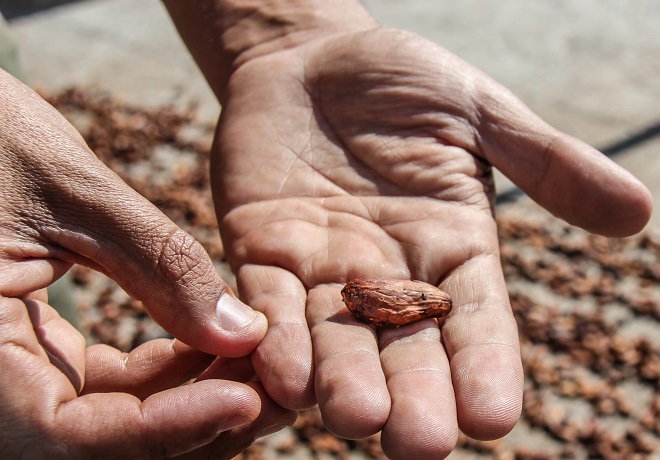Step 1: Harvesting
The process begins with harvesting, which usually occurs twice a year. Because the trees are too fragile to climb, harvesting is accomplished by workers on the ground. Once the pods are cut down the pods are cut open with machetes and the white pulp containing the cocoa beans is scooped out.
Step 2: Fermentation
The beans are placed in earthen pits or wooden bins and covered with banana leaves and left to ferment for five to seven days. Fermentation is the first step in developing the flavour of the chocolate, meaning the individual farmer often have a direct impact on the quality of the finished chocolate.
Step 3: Drying
Once fermentation is complete the beans must be dried. This is often done by laying the beans out flat under the heat of the sun. Some manufacturers try to speed this process along by drying the beans over a fire, which gives them a smoky, inferior flavour. From here, the beans are bagged and shipped around the world.
Step 4: Roasting
Upon arrival at the manufacturing facility, beans are roasted to bring out the intense chocolate flavours and colours. The time and temperature of the roasting depends on the type of beans and their relative moisture levels, and the chocolate makers themselves.
Step 5: Cracking and Winnowing
After roasting, the beans are transferred to a winnower that removes the shells of the beans and leaves the “nibs”—the essence of the cocoa bean that’s full of cocoa solids and cocoa butter.
Step 6: Grinding
The nibs are then ground to a thick, rich paste called chocolate liquor or cocoa mass (a somewhat misleading term, as it actually contains no alcohol). This liquor is the foundation for all chocolate products and contains both cocoa solids and cocoa butter. The cocoa butter is extracted from the chocolate liquor using a hydraulic press, leaving behind a powdery disc. When pulverised, this Presscake, as it is known, becomes common cocoa powder. The extracted cocoa butter is used by manufacturers to give their chocolate a smoother, glossier texture.
Step 7: Conching
To further refine the texture of the final product, and to really bring out the flavour, the mixture then goes through the process of conching. This process can take anything from a few hours to a few days depending on the quality of the final product.
This process affects the chemical structure of the chocolate, as well as the particle size and thus has a huge impact on the flavour notes in the finished chocolate. Deciding exactly how long to conch for is part of the chocolate maker’s skill.
It’s during the conching process that sugar, milk powder (for milk chocolate) and other flavourings are added to the chocolate.
Step 8: Tempering
When you break a piece of chocolate off, you should be met with a good ‘snap’ –the quality of snap is often a sign of the quality of the chocolate, and this is refined during the tempering process. The process is essentially a controlled process of raising, lowering and raising the temperature of the chocolate to form exactly the right kind of crystals. Untempered chocolate is crumbly and soft, and not anything like what we know as chocolate today.
Step 9: Moulding
The final step in the chocolate creation process is to pour the finished chocolate into a mould. Melted chocolate is poured into plastic moulds and agitated to remove air bubbles. Large scale operations rely on machines and conveyors to complete this process, while many smaller chocolatiers still complete this process by hand.

